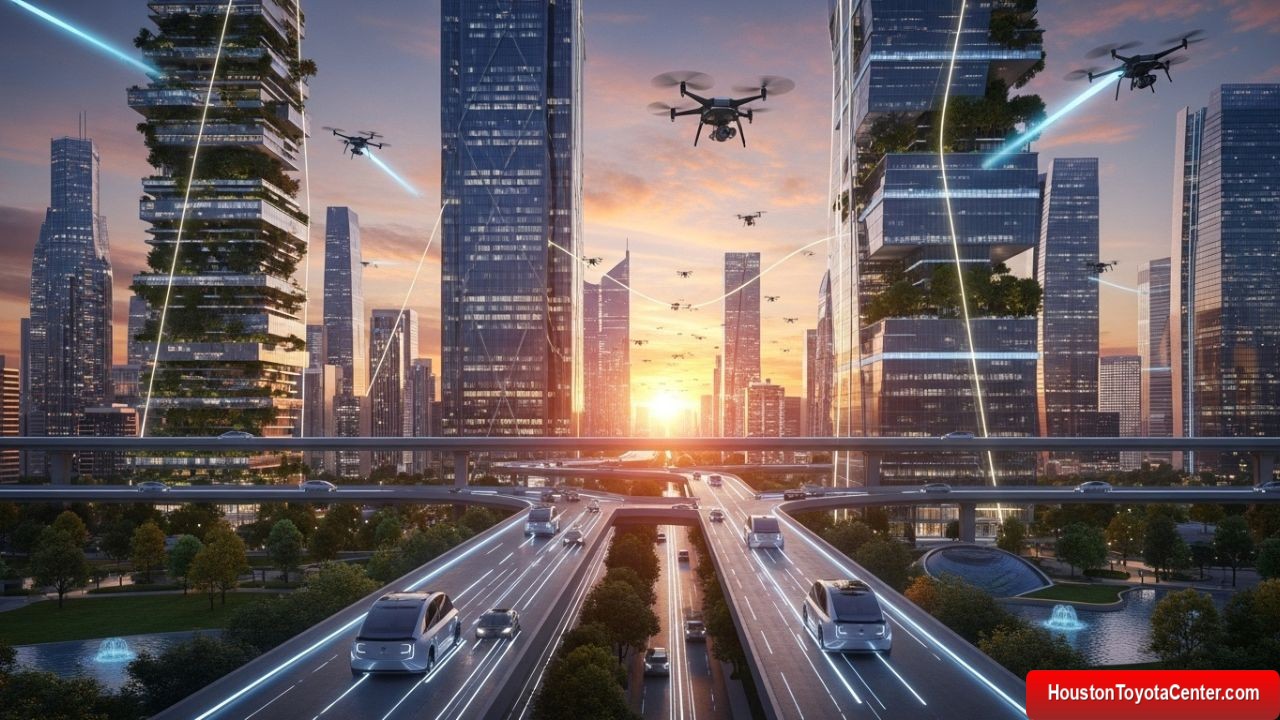In the 21st century, the automotive industry is experiencing the most transformative period in its history. From the earliest combustion engines to modern hybrids and fully electric vehicles, transportation has always evolved with technology — but the changes ahead are far more profound. The future of mobility is shaped by four major pillars: Shared, Autonomous, Electric, and Connected systems, often abbreviated as SAEC or CASE (Connected, Autonomous, Shared, and Electric).
These four trends are not isolated innovations; rather, they form an interdependent ecosystem that will redefine how we move, how cities are built, and even how we think about ownership and sustainability. This article explores each of these pillars, their convergence, and what they mean for consumers, manufacturers, and society at large.
⚡ 1. The Rise of Electric Mobility
Electric vehicles (EVs) have emerged as the cornerstone of sustainable transportation. As governments around the world tighten emissions regulations and push for carbon neutrality, automakers are accelerating the shift away from fossil fuels.
Why Electric Mobility Matters
Electric vehicles produce zero tailpipe emissions, which significantly reduces air pollution in cities. Beyond environmental benefits, EVs also offer smoother acceleration, quieter rides, and lower maintenance costs compared to internal combustion engine (ICE) vehicles.
FREE: Quickly identify and understand problems with your vehicle 🚘
CLICK HEREBattery Technology: The Heart of the EV Revolution
The key to mass EV adoption lies in battery technology. Over the past decade, lithium-ion batteries have become more efficient, affordable, and durable. Innovations like solid-state batteries and sodium-ion cells promise even greater energy density, faster charging times, and reduced dependency on rare earth materials such as cobalt.
| Battery Type | Energy Density (Wh/kg) | Charging Time | Lifecycle (cycles) | Key Advantage |
|---|---|---|---|---|
| Lithium-Ion | 200–250 | 30–60 minutes | 1,000–2,000 | Proven reliability |
| Solid-State | 400–500 | 10–20 minutes | 2,000–5,000 | High energy, safety |
| Sodium-Ion | 150–200 | 20–40 minutes | 1,000–1,500 | Lower cost, abundant materials |
Charging Infrastructure and Range Anxiety
One of the biggest barriers to EV adoption remains the availability of charging infrastructure. However, cities, utility companies, and private firms are investing heavily in fast-charging networks. The introduction of ultra-fast 350 kW chargers now enables drivers to gain up to 300 miles of range in just 20 minutes.
In the near future, wireless charging roads and vehicle-to-grid (V2G) systems will allow EVs to both draw and supply power, creating a two-way energy ecosystem that stabilizes the electric grid.
🤖 2. The Dawn of Autonomous Driving
Autonomous vehicles (AVs) represent the next great leap in transportation. Once considered science fiction, self-driving cars are now being tested on public roads across the world by companies like Waymo, Tesla, and Toyota.
Levels of Autonomy
Autonomous driving is categorized by six levels defined by the SAE (Society of Automotive Engineers):
| Level | Description | Human Role |
|---|---|---|
| 0 | No Automation | Full control by driver |
| 1 | Driver Assistance | Adaptive cruise control |
| 2 | Partial Automation | Steering + acceleration assistance |
| 3 | Conditional Automation | Car drives under certain conditions |
| 4 | High Automation | No driver input in most scenarios |
| 5 | Full Automation | Fully self-driving under all conditions |
Today, most consumer vehicles operate at Level 2 or 3, offering semi-autonomous capabilities such as lane centering, adaptive cruise control, and automatic braking. However, the march toward Level 5 autonomy is underway.
How Autonomous Cars “See” the World
Self-driving systems use a combination of sensors, cameras, radar, LiDAR, and AI algorithms to detect obstacles, read road signs, and make driving decisions. The fusion of these technologies allows AVs to process vast amounts of data in milliseconds.
Artificial intelligence, particularly machine learning and deep neural networks, enables vehicles to learn from real-world driving scenarios. As the global fleet of connected vehicles grows, these systems continuously improve through data sharing.
Safety, Ethics, and Regulation
While autonomous vehicles promise to eliminate human error (which causes over 90% of accidents), ethical dilemmas remain. Regulators must decide who is responsible when an autonomous vehicle causes harm — the manufacturer, the software developer, or the passenger?
Governments are developing frameworks for liability, insurance, and cybersecurity to ensure public safety while fostering innovation.
🚗 3. Shared Mobility and the End of Ownership
Car ownership, once a symbol of independence, is evolving. In dense urban environments, owning a private car is becoming less practical and more expensive. The rise of ride-hailing, car-sharing, and micro-mobility services (like e-scooters and shared bikes) reflects a generational shift in how people view transportation.
The Sharing Economy in Motion
Platforms such as Uber, Lyft, and Turo have normalized the concept of on-demand mobility. Instead of purchasing vehicles, consumers are opting for subscription-based models that offer flexibility without long-term commitment.
Economic and Environmental Benefits
Shared mobility reduces the number of vehicles on the road, lowering emissions and congestion. Studies show that each shared vehicle can replace up to 9–13 privately owned cars, leading to cleaner air and less traffic.
| Mobility Model | Ownership | Average Cost | Environmental Impact |
|---|---|---|---|
| Traditional Car Ownership | Individual | High (fuel, maintenance, insurance) | High emissions |
| Ride-Hailing | Shared | Medium | Moderate |
| Car-Sharing | Shared | Low | Low emissions |
| Micro-Mobility (E-scooters/Bikes) | Shared | Very Low | Minimal impact |
The Future of Shared Fleets
In the coming years, expect shared autonomous electric fleets — driverless vehicles that can be summoned via app, charged automatically, and serviced remotely. This model merges all four trends into one seamless experience.
Imagine a world where you wake up, open your app, and a clean, quiet, self-driving electric car arrives at your door — shared by the community, but personalized for your preferences.
🌐 4. The Power of Connectivity
The final pillar, connectivity, ties everything together. Connected vehicles communicate not only with drivers but also with other cars, infrastructure, and the cloud — a system known as V2X (Vehicle-to-Everything).
The Connected Vehicle Ecosystem
V2X technology includes:
- V2V (Vehicle-to-Vehicle): Cars share speed and location data to prevent collisions.
- V2I (Vehicle-to-Infrastructure): Vehicles interact with traffic lights and road sensors.
- V2G (Vehicle-to-Grid): EVs exchange power with the grid.
- V2P (Vehicle-to-Pedestrian): Cars detect pedestrians and cyclists.
This constant exchange of data creates a real-time traffic network, enabling smarter routing, reduced congestion, and enhanced safety.
5G and Beyond
The rollout of 5G networks accelerates this transformation by enabling low-latency communication. Future 6G systems will make vehicles even more responsive, supporting edge computing where data is processed instantly at the source.
Cybersecurity and Data Privacy
However, increased connectivity introduces risks. Hackers could potentially exploit connected systems, so cybersecurity must evolve in parallel. Manufacturers are implementing blockchain, end-to-end encryption, and AI threat detection to secure vehicles against digital attacks.
🌱 The Intersection of All Four Trends
The future of mobility lies in the integration of these technologies:
- Electric vehicles provide clean energy.
- Autonomous systems deliver safety and convenience.
- Shared models promote efficiency and accessibility.
- Connected networks tie everything together.
When these trends converge, they create a seamless, intelligent, and sustainable transportation ecosystem — one that prioritizes both people and the planet.
🚀 Transforming Cities and Societies
Mobility is more than movement — it shapes cities, economies, and lifestyles. The SAEC revolution will redefine urban planning, energy consumption, and employment patterns.
Smart Cities and Urban Design
Cities of the future will integrate smart grids, autonomous public transport, and dedicated EV lanes. Parking lots may be repurposed into green spaces as shared vehicles reduce the need for car ownership.
Economic Shifts
The automotive industry will increasingly resemble the tech industry, where software, data analytics, and digital services drive value. Jobs will evolve from traditional mechanics to data engineers, battery specialists, and AI safety experts.
Environmental Impact
Transitioning to shared, electric, and autonomous vehicles could cut global CO₂ emissions by up to 80% by 2050, according to studies by the International Energy Agency (IEA). The future of mobility is not just about efficiency — it’s about planetary survival.
🔋 Challenges Ahead
Despite the optimism, challenges remain:
- Infrastructure Gaps: Charging stations and 5G coverage are still limited in many regions.
- High Costs: Autonomous and electric technologies remain expensive for mass markets.
- Public Trust: People must feel safe sharing rides and trusting AI-driven vehicles.
- Regulatory Hurdles: Governments need to harmonize safety and data privacy laws globally.
Yet history shows that innovation always begins with challenges — and mobility is no exception.
🌎 A Vision of Tomorrow
By 2040, the roads may look completely different. Silent electric cars, guided by invisible networks, glide through cities where ownership is optional, traffic is minimal, and air is cleaner.
People will spend less time driving and more time living — reading, relaxing, or even working while their vehicles handle the journey.
The mobility revolution is not about technology alone; it’s about freedom, equality, and sustainability. The future of transportation is not just shared, autonomous, electric, and connected — it’s human-centered.
🧭 Conclusion
The journey toward the future of mobility is already underway. Each innovation — from AI-driven navigation to shared fleets of electric cars — brings us closer to a world where transportation is cleaner, smarter, and more accessible.
The Toyota Center in Houston and similar forward-thinking institutions are at the heart of this transformation, supporting education, testing, and technology that will define how humanity moves in the decades to come.
The road ahead is electrified, autonomous, and connected — and it’s leading us toward a sustainable, inclusive future for all.


Leave a Reply